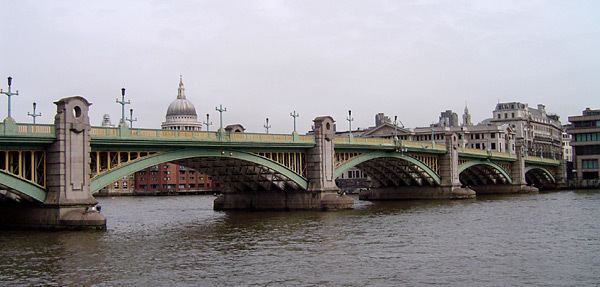Carries A300 road Construction started 1913 Clearance below 7.4 m | Opened 1921 Total length 244 m | |
 | ||
Heritage status Grade II listed structure Address Southwark Bridge Rd, London EC4R 1QS, UK Similar River Thames, Millennium Bridge - London, Cannon Street Railway, Blackfriars Bridge, Vauxhall Bridge | ||
Bridging london tower bridge southwark bridge millennium bridge 2013
Southwark (Br [ˈsʌðɨk]) Bridge is an arch bridge in London, England, for traffic linking the district of Southwark and the City across the River Thames. It has the lowest traffic utilisation of any bridge in central London.
Contents
- Bridging london tower bridge southwark bridge millennium bridge 2013
- Driving in london southwark bridge to elephant and castle
- History
- Nearby
- Popular culture
- References
Driving in london southwark bridge to elephant and castle
History
A previous bridge, designed by John Rennie, opened on the site in 1819 and was originally known as Queen Street Bridge, as shown on the 1818 John Snow Map of London. The bridge consisted of three large cast-iron spans supported by granite piers. The bridge was notable for having the longest cast iron span, 240 feet (73 m), ever made. It was a commercial tolled operation which was trying to compete with the toll free Blackfriars and London bridges nearby, but the company became bankrupt and its interest were acquired by the Bridge House Estates which then made it toll free in 1864.
A new bridge on the site was designed by Ernest George and Basil Mott. It was built by Sir William Arrol & Co. and opened in 1921.
Halfway along the bridge on the Western side is a plaque which is inscribed:
Re-built by the Bridge House Estates Committee
of the Corporation of London
1913-1921
Opened for traffic by their Majesties
King George V and Queen Mary
6th June 1921
Sir Ernest Lamb CMG, JP Chairman
Basil Mott, CB Engineer
Sir Ernest George RA Architect
The bridge provides access to Upper Thames Street on the north bank and, due to the ring of steel, there is no further road access to the City and the north. The bridge is owned and maintained by Bridge House Estates, a charitable trust overseen by the City of London Corporation. The current bridge was given Grade II listed structure status in 1995.
Nearby
At the north-west side is Vintners Court, a 1990s office block which has a classical facade of columns and pediment; this was developed on the site owned by the Worshipful Company of Vintners whose Hall is behind it on Upper Thames Street.
The south end is near the Tate Modern, the Clink Prison Museum, the Globe Theatre, and the Financial Times and Ofcom buildings. Below the bridge on the south side are some old steps, which were once used by Thames watermen as a place to moor their boats and wait for customers.
Below the bridge on the south side is a pedestrian tunnel, part of the Queen's Walk Embankment, containing a frieze depicting the Thames frost fairs.
Popular culture
Southwark Bridge appears in many films, including Harry Potter and the Order of the Phoenix (2007).
The cream painted houses on the south side of the bridge, Anchor Terrace, just after the FT building, were used for the exterior shots of the shared house in This Life.
The 1819-1920 "Iron Bridge" is mentioned in the first sentence of "Our Mutual Friend" by Charles Dickens, and several times in his "Little Dorrit", where in Chapter 18 he identifies the toll as being one penny.
In the 1964 Disney film Mary Poppins, the Banks family mistakenly think that George W. Banks has committed suicide by jumping off the bridge after he is fired from his job at the bank.
